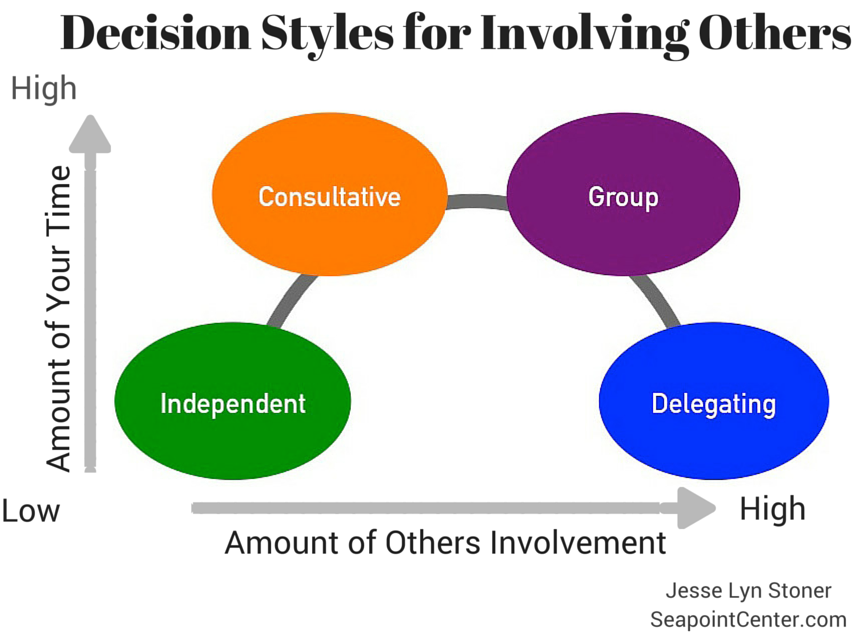 You face countless decisions each day and must determine which to make on your own and when to involve others. This is true no matter what your role or level, whether you are CEO, a project leader, or a team member. How do you know when to involve others in decisions?
You face countless decisions each day and must determine which to make on your own and when to involve others. This is true no matter what your role or level, whether you are CEO, a project leader, or a team member. How do you know when to involve others in decisions?
Most people are guided by personal preference. Some people are decisive by nature or action-oriented. They would rather not to get bogged down by involving others if they can avoid it. Others are collaborative by nature and prefer dialogue and consensus decision-making.
Be Intentional to Be Effective
The problem with being guided by personal preference is that your options are limited. If you are prone to making decisions on your own, you risk making ill-informed decisions and losing support. If you are prone to involving others, you risk wasting time, your own and other’s. In Situational Team Decision-Making: Collaboration Does Not Require Consensus, I describe the 6 types of team decisions and explain how pushing for consensus when it’s not needed can actually make collaboration more difficult.
The 4 Decision Styles
There are four choices for how to involve others in decisions. Understanding your choices and knowing when to use them gets you farther, faster, easier, and with less headaches in the long run.

Independent: You obtain the information you need and make the decision on your own.
Consultative: You ask others for their ideas and opinions (either individually or as a team), but you make the decision.
Group: You bring the question to a group, and through a group discussion a decision is reached that everyone supports. You are a member of the group, and your voice is no more important than anyone else’s.
Delegating: You pass the authority for ensuring a good decision is made to an individual or a group. You are not involved in the decision-making process and agree to support whatever decision is made. Others are involved to a great extent.
The Pros and Cons of Each Decision Style
Independent
Pro: Takes less of your time.
Con: A greater risk of needing to spend time later fixing problems.
Consultative
Pro: Likely to get helpful information and viewpoints you have not considered.
Con: If the people you consult with are invested in their position, they might be upset if you go don’t take their advice. e.g. “You asked my opinion and then ignored it.”
Group
Pro: You make smarter decisions when more viewpoints are considered. And implementation goes faster and smoother because the decision is understood and supported by all. You might spend more time in the beginning, but you will make up for it by spending less time in implementation.
Con: Takes more of your time.
Delegating
Pro: Takes some time to set it up properly, but then takes very little of your time.
Con: You need to let go of control, so it’s important to have confidence in the person or team you are delegating to. Consider the Ten Tips for Effective Delegating.
5 Questions to Help Determine Which Style to Use
1. How much will the decision impact the organization? If the decision will have a significant impact on the organization, don’t assume you know everything you need to know. The best styles to use are Consultative and Group.
2. How much will the decision impact the people who must implement it? The more others are affected by the decision and the more their acceptance of the decision is necessary for effective implementation, the more they should be involved in making the decision. The best style to use is Group. If that’s not realistic, then Consultative (with a lot of conversations).
3. Do you have access to all the information you need to make a good decision? If the decision is low impact, don’t waste people’s time. Are you ordering pencils for the office? Use the Independent style. If the decision is high impact, even when you have the information you need, you need to involve people, especially those who will be expected to implement the decision.
4. What is the team’s stage of development? Teams in earlier stages of team development have not yet developed the ability to make good decisions. They need structure to support their movement through the early stages. The Group style can be effective with facilitation to ensure full and open participation, to help work through conflict productively, and to support their developing into a high performance team.
5. Is there congruence between the goals of the team (or individual) and the organization? Are goals and values of the group and the organization clear and congruent? If you have any doubt, stay involved, and weigh the advice you hear carefully. Avoid using the Delegating style.
Let People Know Which Style You Will Be Using
Often when people are asked their opinion, they assume it means they are part of the decision process. Later if they learn the decision was made with a Consultative style, they can feel misled and might not fully support the decision. To maximize the effectiveness of whatever style you use, let people know which style you’ll be using at the time you ask for their input.













You are one of the MOST clear, logical writers I know. This is so incredibly helpful and the links to other articles offer a depth of knowledge that everyone can benefit from.
There is one other scenario for decision making: emergency or crisis. Time is of the essence. Someone must be in charge: NOW! Frankly,this is where natural leadership arises and when people panic, the leader does not consult, take a vote but rather spring into action. Consider Captain Chesley “Sully” Sullenberger and the decisions he made that saved all 159 passengers when he landed his US Air plane in the Hudson. But here’s the important thing: “Sully” never took his skill for granted. He constantly trained for emergencies. That training took over. But what do organizations cut back in economic downturns: training. Something to think about.
So glad you raised the question about emergencies! Great story about Captain Sully. Indeed, if the plane is crashing, it doesn’t make sense to call a group together to discuss options. However, most situations are not as urgent as they seem, and it’s important to keep in mind the potential for bad decisions when under an intense deadline. And of course, your point about the importance of training and being prepared is well taken. As always, much thanks for your insights!
These are excellent for understanding even the quality of our own decision making. I really like your advice to tell people which method you’re using. Like that always happens – never.
It’s amazing what a difference it makes when you let people know in advance. Thanks calling out that important point. And also for your observation that this model can apply to your personal life as well.
Excellently written, accurate and precise. I shared this with many of my friends who are in the development field and all appreciated. As we use participatory approaches we always apply group decision making approach. In a very critical moment one may make a decision, but again weighing all options accurately. We usually say use your own best judgement, but, it should be after weighing all options accurately. Maestro Dr. Robert Chambers speaks about this often and we use the Participatory Reflection and Action (earlier known as Participatory Rural Appraisal) methodology introduced by him. When group decision making approach is applied, makes everyone responsible as the decision is owned by them. I am so grateful to you for making this clear to us.
Thank you for your kind words. The goals of PAR are noble, and it has a strong history influenced by the work of Paulo Freire, Kurt Lewin and others. I am so pleased that my article is helpful to your group and the work you do.
Jesse, for most managers decision making is like a coin toss/ flip. On the coin’s Head side there are all the rational, factual aspects. On the Tails side, all the aspects that relate to emotions and feelings.
Trouble is these managers keep tossing the coin until they get a Head. Or they use a 2-Headed coin. Or they cheat, imagining that no matter what side lands upright, they call out “It’s Heads.”
It’s only at the start of football games that decision making is as simple as tossing a coin. And so the place to start when it comes to “5 Questions to Help Determine Which Style to Use” #5 should be #1.
It’s hard to add anything to your comments, Mark, except.. oh yeah!